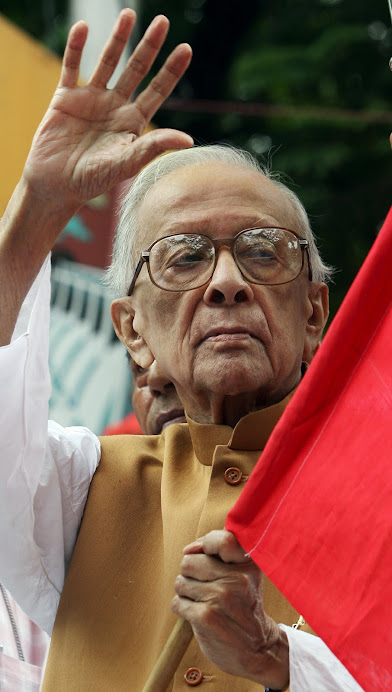+in+a+family+photo+in+Nagapada.+Photo-Rakib+Ahmed.jpg) Time’s work A young Jyoti Basu (second from left) in a family photo in Nagapada
Time’s work A young Jyoti Basu (second from left) in a family photo in Nagapada Bangladesh plans a memorial at Jyoti Basu’s ancestral village
We drive 10 km down the Dhaka-Chittagong highway and swing into the interiors, only to crawl along the narrow road meandering under a canopy of banana and palm leaves. Strewn on either side are white shipla or water lilies, Bangladesh’s national flower. Beyond the road, as far as the eye can see, farmers in quaint hand-made boats are fishing in water-logged paddy fields. After about 10 km, we come upon, and stare bewitched at, the Meghna river—a tributary of the Brahmaputra but just as mighty and expansive. Here the road turns a bend, suddenly bringing into view Chowdhury Para, a hamlet in Barodi pargana of the Sonargaon subdivision. In this nondescript village is located the ancestral house of Jyoti Basu, the late Marxist leader, one who shaped the redoubtable election-winning CPI(M) regime in West Bengal and dominated Bengal politics for three decades.
Chowdhury Para has acquired fame here in recent weeks, courtesy the Bangladesh government’s decision to convert Basu’s ancestral house, called Nagapada, into a library-cum-tourist complex. This could well inaugurate a new chapter in Indo-Bangladesh relations, often marked by suspicion, animosity and, occasionally, armed skirmishes along the porous border. It could—who knows—even become a symbol of common civilisational links between the two countries, torn asunder so cruelly six decades ago.
.jpg)
Time hasn’t spared Nagapada—the paint has peeled off, the driveway linking the entrance to the rear is overgrown with weeds. Yet, miraculously, a piece of the past survives here, not only through the framed, sepia-faded family photos that still hang on the walls, or the odd surviving armchair or bedstead. It is nurtured by the memory of 80-year-old Mohammmed Shahidul, the owner and caretaker of Basu’s ancestral house.
The government’s decision to convert Nagapada into a tourist complex should have enthused Shahidul, render light as it would his task of preserving the zamindari abode of Nishikanta. Instead, he is inconsolable at its very mention. Subjected to the whims of history—two partitions and torn homes—he fears the project would blight his last days. “It will be painful, very, very painful if I am asked to leave, at this stage in life,” he laments amid loud sobs. You can’t but empathise—four generations of his family, starting with his mother Ayatonissa, have lived in Nagapada. This is his home; he has nowhere to go.
.jpg)
Memory’s Last Stand
- Nagapada is Jyoti Basu’s ancestral house. It’s located in Chowdhury Para of Sonargaon subdivision, 20 km from Dhaka
- It’s a two-storeyed house, built on 2.04 acres
- The government plans to convert it into a library-cum-tourist complex, and a memorial. Expected to be complete in 2012.
- Those living in Nagapada for four generations fear eviction
***
Jyoti Basu, too, never forgot the caretakers of Nagapada. Dates don’t come to him easily at this age, but Shahidul recalls meeting Basu in Writer’s Building and in the Basu household in Calcutta. He says the leader would affectionately address him as ‘Kaka’ and ‘Baboo’. For his part, Basu could visit Chowdhury Para only twice—in January 1987 and November 1999.
Gen Ershad was in power in 1987. Senior journalist Rahman Jahangir recalls that Basu landed in Chowdhury Para in a helicopter and addressed an impromptu gathering of locals. The one single memory of that speech which stands out, says Jahangir, was Basu’s repeated reference to Sheikh Mujibur Rahman as ‘Mujib’, a near-blasphemy in these parts, where even the leader’s bitterest detractors would address him as Bangabandhu. The two leaders became friends during the Awami League’s government-in-exile that operated out of Calcutta, spearheading the fight against Pakistan. “The Communists played a key part in hosting nearly 10 million Bangladeshi refugees, which neither Mujib nor his daughter Sheikh Hasina ever forgot,” says Jahangir.
No wonder then that Hasina has put her formidable weight behind the idea of converting Nagapada into a library-cum-tourist complex. Says Awami League leader Obaidul Qader, who has been entrusted to oversee the project, “The PM has also cleared my proposal for the construction of a memorial. It will be completed by 2012.” A pause later, he adds, “He is a great leader of the subcontinent. And he was from Bangladesh. So he was a Bangladeshi as well. The people here love him.”
http://www.outlookindia.com/printarticle.aspx?266972
|
